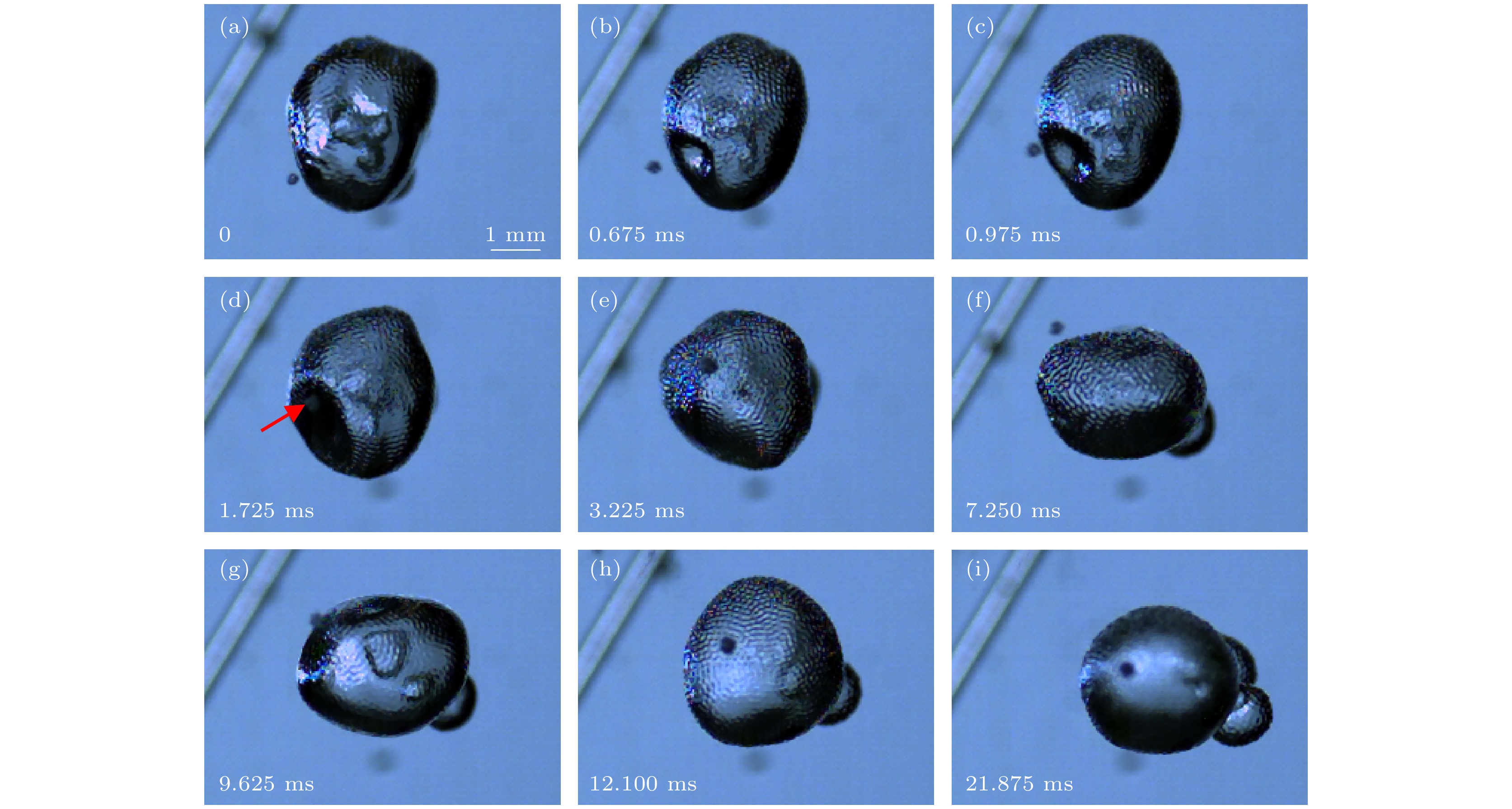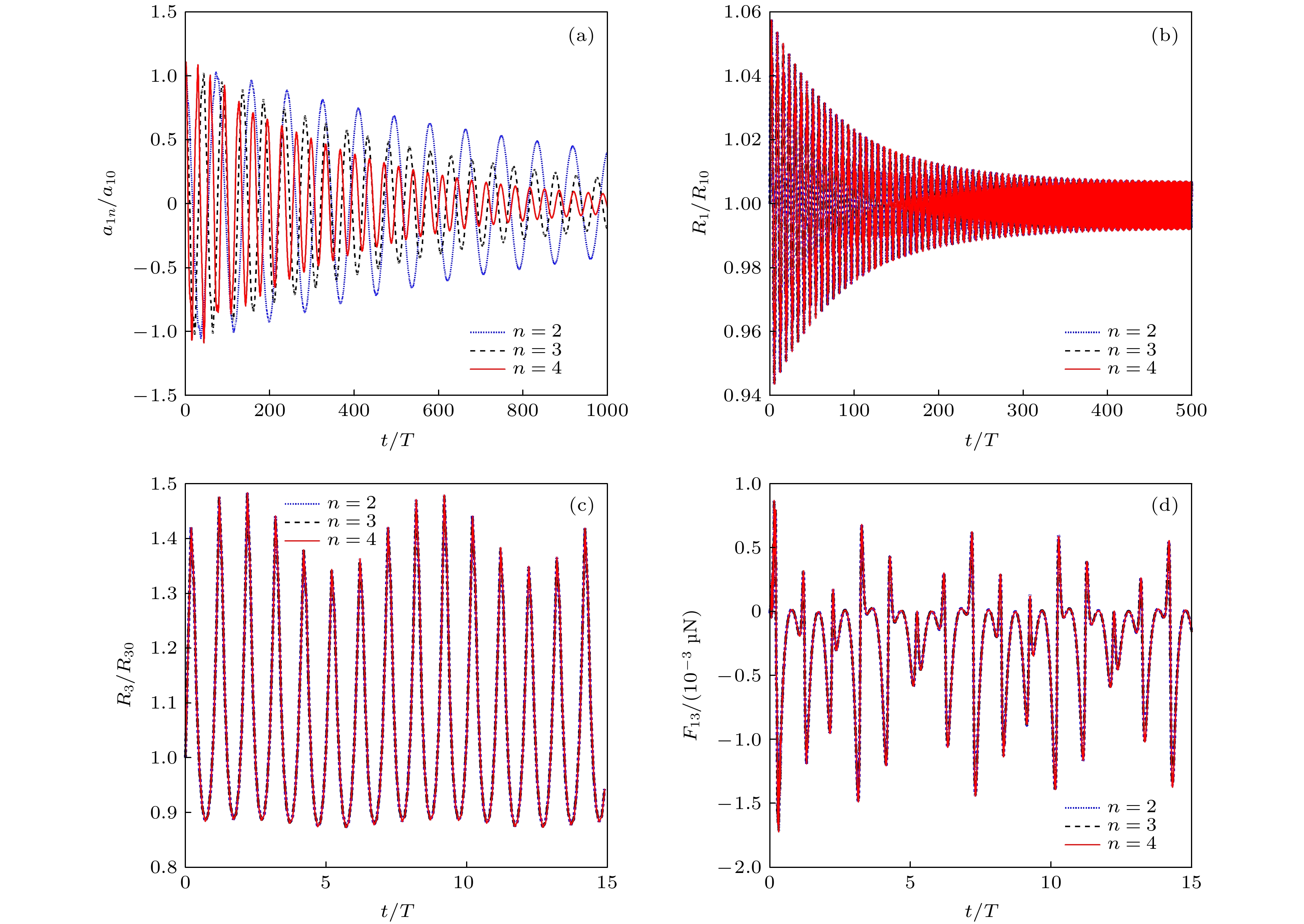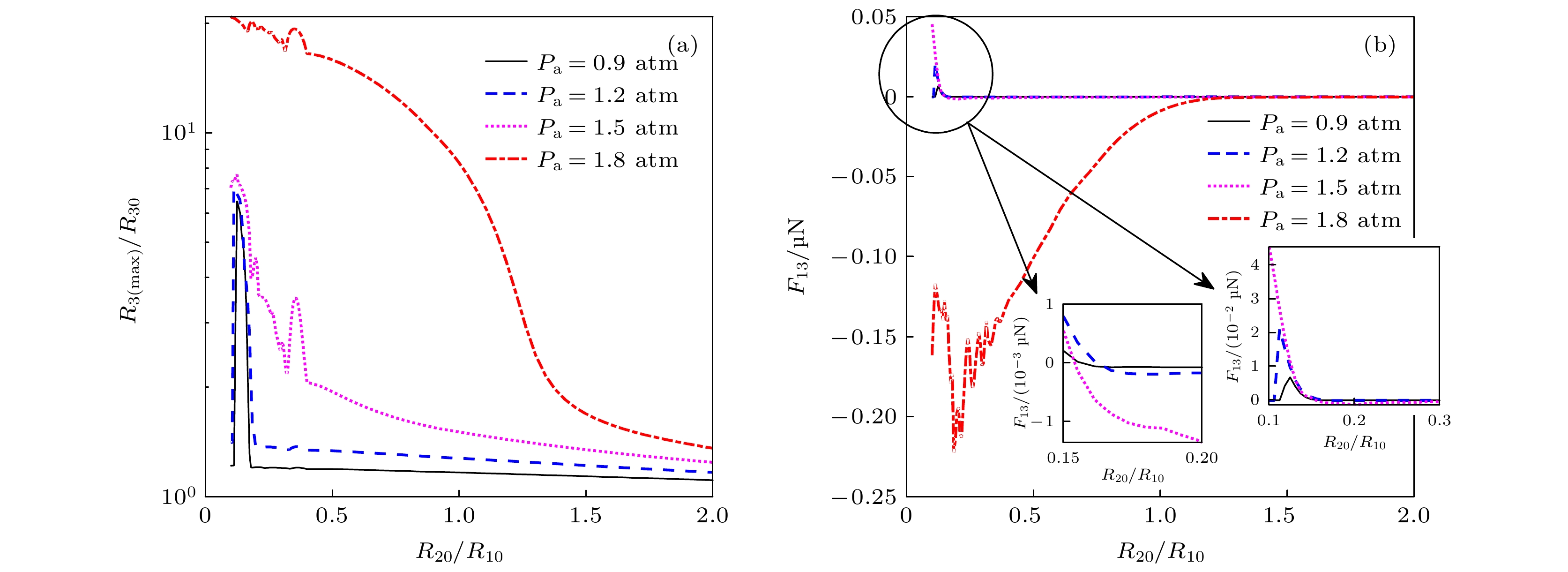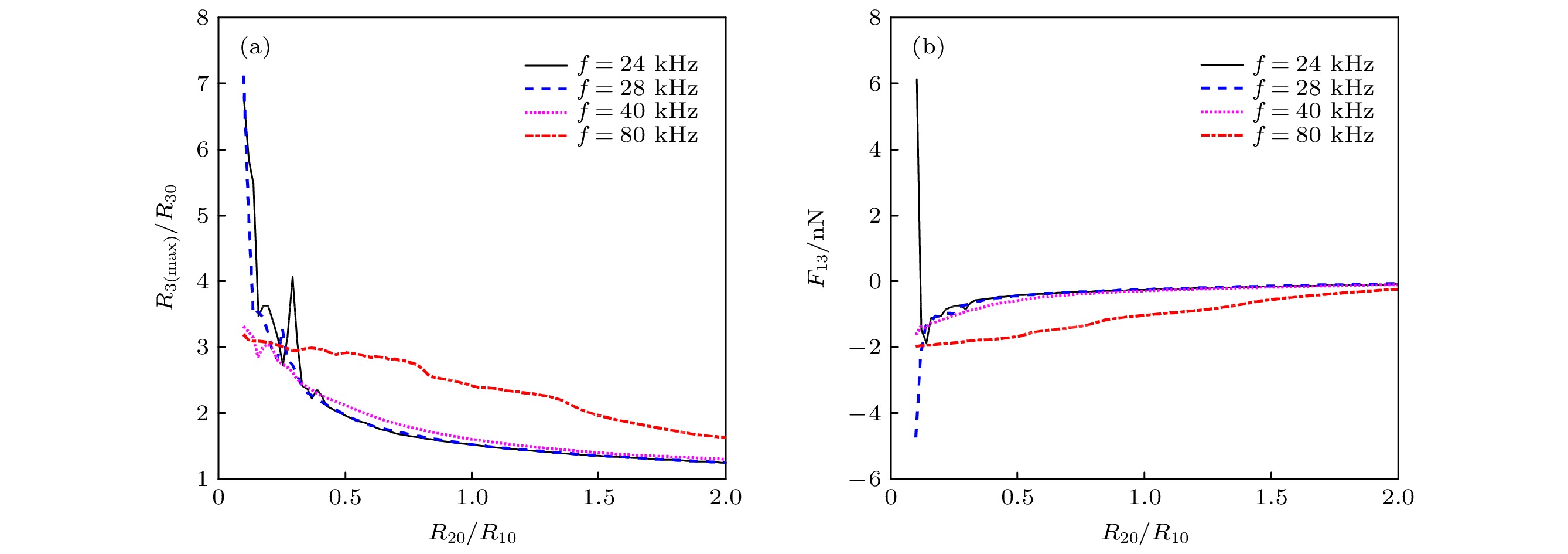-
为探究空化场中多气泡之间的相互作用, 结合观察到的注入大气泡周围飞舞的小气泡的实验现象, 构建了由两个大气泡和一个空化泡组成的三气泡系统, 通过考虑气泡间相互作用的时间延迟效应以及大泡的非球形振动, 得到修正的气泡动力学方程组, 并数值分析了气泡的振动模态、平衡半径、声波压力与频率等参量对小空化气泡的振动行为与所受次级Bjerknes力的影响. 结果表明, 大气泡的非球形效应主要表现为一种近场效应, 对空化泡的振动影响很小, 几乎可以忽略不计. 大气泡可抑制空化泡的振动, 但当大气泡半径接近于共振半径时, 空化泡振动幅值曲线出现共振峰, 即存在耦合共振响应. 大气泡半径越大, 对空化泡抑制作用越强, 当空化泡处在两个毫米级大气泡附近时抑制更加显著. 声波压力与频率不仅直接影响气泡的振动, 还影响空化泡与大气泡之间相互作用的强弱, 表现为空化泡所受的次级Bjerknes力在特定的大气泡半径范围内变得对气泡尺寸变化较为敏感, 即小的大气泡半径变化可能导致明显的力大小变化, 且不同驱动频率下, 空化泡所受次级Bjerknes力的敏感半径分布区间不同. 空化泡受到的次级Bjerknes力在距离较小或者较大时均可能表现为斥力, 与实验观察现象一致. 随着声波压力的增大, 气泡间距影响下的力响应模式可能不同, 甚至可能出现在特定距离内因声反常吸收而导致的作用力减弱现象.
-
关键词:
- 多气泡系统 /
- 次级Bjerknes力 /
- 相互作用
In this work, the interaction among multiple bubbles in a cavitation field is investigated by combining the experimental observation of small bubbles hovering around large bubbles. A model composed of three bubbles is developed, and the dynamic behavior of cavitation bubble is analyzed. By considering the time delay effect of the interaction among bubbles and the nonspherical oscillation of large bubbles, the modified bubble dynamic equations are obtained. Numerical results show that the nonspherical effect of large bubbles has little effect on the oscillation of cavitation bubble. The suppressive effect of large bubble on cavitation bubble is closely related to the radius of the large bubble. The larger the size of the large bubble, the stronger the suppression is. When the size of large bubble approaches to the resonant radius, the oscillation of cavitation bubble presents coupled resonance response, and the maximum expansion radius of bubble shows a resonance peak. The distribution of the secondary Bjerknes force versus bubble radius and the separation distance is strongly influenced by driving frequencies or sound pressure. When the large bubble is on the order of submillimeter, the intensity of the secondary Bjerknes force and the acoustic response mode are different due to the different intensity of the nonlinear response of the cavitation bubble. As the distance decreases, when the acoustic pressure increases to a certain value, the secondary Bjerknes force on the cavitation bubble decreases due to abnormal acoustic absorption. The secondary Bjerknes force on cavitation bubble is likely to be repulsive at different separation distances. The theoretical results accord well with experimental phenomenon.-
Keywords:
- multi-bubble system /
- secondary Bjerknes force /
- interaction
[1] Neppiras E A 1980 Phys. Rep. 61 159
 Google Scholar
Google Scholar
[2] 冯若, 赵逸云, 陈兆华, 黄金兰, 王双维, 莫喜平, 李华茂, 朱昌平 1994 声学技术 13 56
Feng R, Zhao Y Y, Chen Z H, Huang J L, Wang S X, Mo X P, Li H M, Zhu C P 1994 Tech. Acoust. 13 56
[3] Galleguillos R 2022 Appl. Acoust. 192 108716
 Google Scholar
Google Scholar
[4] Brenner M P, Hilgenfeldt S, Lohse D 2002 Rev. Mod. Phys. 74 425
 Google Scholar
Google Scholar
[5] Miller D L 1987 Ultrasound Med. Biol. 13 443
 Google Scholar
Google Scholar
[6] Lu X Z, Chahine G L, Hsiao C T 2012 J. Acoust. Soc. Am. 131 24
 Google Scholar
Google Scholar
[7] Plessett M S, Prosperetti A 1977 Ann. Rev. Fluid Mech. 9 145
 Google Scholar
Google Scholar
[8] Keller J B, Miksis M 1980 J. Acoust. Soc. Am. 68 628
 Google Scholar
Google Scholar
[9] Lauterborn W 1976 J. Acoust. Soc. Am. 59 283
 Google Scholar
Google Scholar
[10] Bjerknes V F K 1906 Fields of Force (New York: Columbia University Press) pp29–55
[11] Lauterborn W, Kurz T 2010 Rep. Prog. Phys. 73 106501
 Google Scholar
Google Scholar
[12] Zhang X M, Li F, Wang C, Mo R, Hu J, Guo J, Lin S 2022 Ultrasonics 126 106809
 Google Scholar
Google Scholar
[13] Li F, Zhang X M, Tian H, Hu J, Chen S, Mo R Y, Wang C, Guo J 2022 Ultrason. Sonochem. 87 106057
 Google Scholar
Google Scholar
[14] An Y 2011 Phys. Rev. E 83 066313
 Google Scholar
Google Scholar
[15] Ida M, Naoe T, Futakawa M 2007 Phys. Rev. E 76 046309
 Google Scholar
Google Scholar
[16] 张鹏利, 林书玉 2009 物理学报 58 7797
 Google Scholar
Google Scholar
Zhang P L, Lin S Y 2009 Acta Phys. Sin. 58 7797
 Google Scholar
Google Scholar
[17] Qin D, Zou Q Q, Lei S, Wang W, Li Z Y 2021 Ultrason. Sonochem. 78 105712
 Google Scholar
Google Scholar
[18] Ma Y, Zhang G Q, Ma T 2022 Ultrason. Sonochem. 84 105953
 Google Scholar
Google Scholar
[19] Chen H Y, Chen Z L, Li Y 2020 Ultrason. Sonochem. 61 104814
 Google Scholar
Google Scholar
[20] 李凡, 张先梅, 田华, 胡静, 陈时, 王成会, 郭建中, 莫润阳 2022 物理学报 71 084303
 Google Scholar
Google Scholar
Li F, Zhang X M, Tian H, Hu J, Chen S, Wang C H, Guo J Z, Mo R Y 2022 Acta Phys. Sin. 71 084303
 Google Scholar
Google Scholar
[21] Keller J B, Kolodner I I 1956 J. Appl. Phys. 27 1152
 Google Scholar
Google Scholar
[22] Brenner M P, Lohse D, Dupont T F 1995 Phys. Rev. Lett. 75 954
 Google Scholar
Google Scholar
[23] Mettin R, Akhatov I, Parlitz U, Ohl C D, Lauterborn W 1997 Phys. Rev. E 56 2924
[24] Doinikov A A, Zavtrak S T 1996 Ultrasonics 34 807
 Google Scholar
Google Scholar
[25] Yasui K, Iida Y, Tuziuti T, Kozuka T, Towata A 2008 Phys. Rev. E 77 1
 Google Scholar
Google Scholar
[26] Nguyen B Q H, Maksymov I S, Suslov S A 2021 Sci. Rep. 11 1
 Google Scholar
Google Scholar
-
图 6 气泡1和3之间的次级Bjerknes力随气泡2和气泡3半径的变化 (a)声波频率为28 kHz; (b) 声波频率为40 kHz; (c) 声波频率为80 kHz
Fig. 6. Variation of the secondary Bjerknes force between bubbles 1 and 3 with the radius of bubbles 2 and 3: (a) Acoustic frequencies is 28 kHz; (b) acoustic frequencies is 40 kHz; (c) acoustic frequencies is 80 kHz.
图 7 气泡1和3之间的次级Bjerknes力随驱动声压幅值以及垂直距离h的变化 (a) 声波频率为20 kHz; (b) 声波频率为40 kHz; (c) 声波频率为80 kHz.
Fig. 7. Variation of the secondary Bjerknes force between bubbles 1 and 3 with the driving sound pressure amplitude and the vertical distance h: (a) Acoustic frequency is 20 kHz; (b) acoustic frequency is 40 kHz; (c) acoustic frequency is 80 kHz.
图 8 气泡1和3之间的次级Bjerknes力随驱动声波频率以及垂直距离h的变化 (a) 驱动声压幅值为1.6 atm; (b) 驱动声压幅值为1.8 atm; (c) 驱动声压幅值为2.0 atm
Fig. 8. Variation of the secondary Bjerknes force between bubbles 1 and 3 with the driving acoustic frequency and the vertical distance h: (a) Driving sound pressure amplitude is 1.6 atm; (b) driving sound pressure amplitude is 1.8 atm; (c) driving sound pressure amplitude is 2.0 atm.
-
[1] Neppiras E A 1980 Phys. Rep. 61 159
 Google Scholar
Google Scholar
[2] 冯若, 赵逸云, 陈兆华, 黄金兰, 王双维, 莫喜平, 李华茂, 朱昌平 1994 声学技术 13 56
Feng R, Zhao Y Y, Chen Z H, Huang J L, Wang S X, Mo X P, Li H M, Zhu C P 1994 Tech. Acoust. 13 56
[3] Galleguillos R 2022 Appl. Acoust. 192 108716
 Google Scholar
Google Scholar
[4] Brenner M P, Hilgenfeldt S, Lohse D 2002 Rev. Mod. Phys. 74 425
 Google Scholar
Google Scholar
[5] Miller D L 1987 Ultrasound Med. Biol. 13 443
 Google Scholar
Google Scholar
[6] Lu X Z, Chahine G L, Hsiao C T 2012 J. Acoust. Soc. Am. 131 24
 Google Scholar
Google Scholar
[7] Plessett M S, Prosperetti A 1977 Ann. Rev. Fluid Mech. 9 145
 Google Scholar
Google Scholar
[8] Keller J B, Miksis M 1980 J. Acoust. Soc. Am. 68 628
 Google Scholar
Google Scholar
[9] Lauterborn W 1976 J. Acoust. Soc. Am. 59 283
 Google Scholar
Google Scholar
[10] Bjerknes V F K 1906 Fields of Force (New York: Columbia University Press) pp29–55
[11] Lauterborn W, Kurz T 2010 Rep. Prog. Phys. 73 106501
 Google Scholar
Google Scholar
[12] Zhang X M, Li F, Wang C, Mo R, Hu J, Guo J, Lin S 2022 Ultrasonics 126 106809
 Google Scholar
Google Scholar
[13] Li F, Zhang X M, Tian H, Hu J, Chen S, Mo R Y, Wang C, Guo J 2022 Ultrason. Sonochem. 87 106057
 Google Scholar
Google Scholar
[14] An Y 2011 Phys. Rev. E 83 066313
 Google Scholar
Google Scholar
[15] Ida M, Naoe T, Futakawa M 2007 Phys. Rev. E 76 046309
 Google Scholar
Google Scholar
[16] 张鹏利, 林书玉 2009 物理学报 58 7797
 Google Scholar
Google Scholar
Zhang P L, Lin S Y 2009 Acta Phys. Sin. 58 7797
 Google Scholar
Google Scholar
[17] Qin D, Zou Q Q, Lei S, Wang W, Li Z Y 2021 Ultrason. Sonochem. 78 105712
 Google Scholar
Google Scholar
[18] Ma Y, Zhang G Q, Ma T 2022 Ultrason. Sonochem. 84 105953
 Google Scholar
Google Scholar
[19] Chen H Y, Chen Z L, Li Y 2020 Ultrason. Sonochem. 61 104814
 Google Scholar
Google Scholar
[20] 李凡, 张先梅, 田华, 胡静, 陈时, 王成会, 郭建中, 莫润阳 2022 物理学报 71 084303
 Google Scholar
Google Scholar
Li F, Zhang X M, Tian H, Hu J, Chen S, Wang C H, Guo J Z, Mo R Y 2022 Acta Phys. Sin. 71 084303
 Google Scholar
Google Scholar
[21] Keller J B, Kolodner I I 1956 J. Appl. Phys. 27 1152
 Google Scholar
Google Scholar
[22] Brenner M P, Lohse D, Dupont T F 1995 Phys. Rev. Lett. 75 954
 Google Scholar
Google Scholar
[23] Mettin R, Akhatov I, Parlitz U, Ohl C D, Lauterborn W 1997 Phys. Rev. E 56 2924
[24] Doinikov A A, Zavtrak S T 1996 Ultrasonics 34 807
 Google Scholar
Google Scholar
[25] Yasui K, Iida Y, Tuziuti T, Kozuka T, Towata A 2008 Phys. Rev. E 77 1
 Google Scholar
Google Scholar
[26] Nguyen B Q H, Maksymov I S, Suslov S A 2021 Sci. Rep. 11 1
 Google Scholar
Google Scholar
计量
- 文章访问数: 7532
- PDF下载量: 321
- 被引次数: 0














 下载:
下载:







